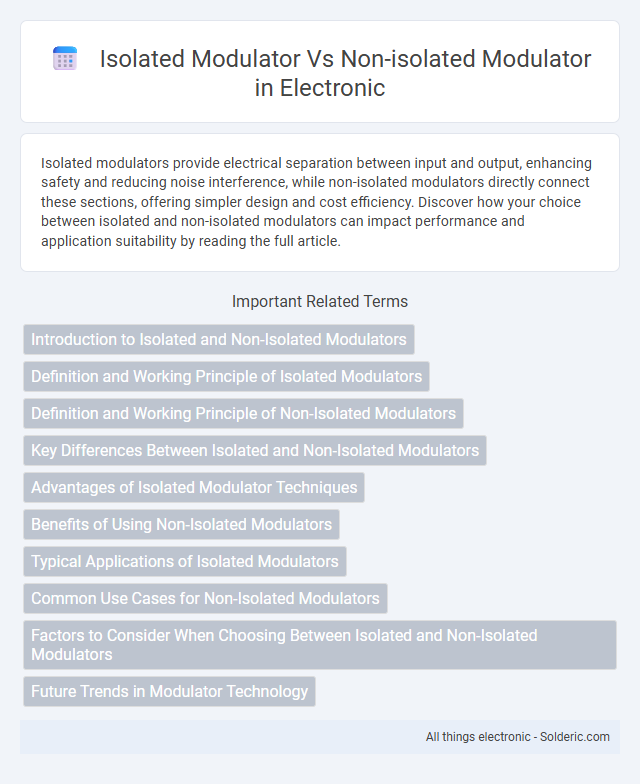Isolated modulators provide electrical separation between input and output, enhancing safety and reducing noise interference, while non-isolated modulators directly connect these sections, offering simpler design and cost efficiency. Discover how your choice between isolated and non-isolated modulators can impact performance and application suitability by reading the full article.
Comparison Table
| Feature | Isolated Modulator | Non-Isolated Modulator |
|---|---|---|
| Electrical Isolation | Provides galvanic isolation between input and output | No galvanic isolation; input and output share a common ground |
| Safety | Enhanced safety in high-voltage environments | Less safe for high-voltage or sensitive applications |
| Noise Immunity | Better noise rejection due to isolation | More susceptible to noise and interference |
| Complexity & Cost | More complex design; higher cost | Simpler design; lower cost |
| Size & Weight | Generally larger and heavier due to isolation components | Compact and lightweight |
| Applications | Industrial automation, medical devices, high-voltage systems | Consumer electronics, low-voltage applications, prototyping |
| Signal Integrity | Higher signal integrity with reduced ground loop issues | Potential ground loop problems affecting signal quality |
Introduction to Isolated and Non-Isolated Modulators
Isolated modulators feature galvanic isolation between input and output, protecting sensitive circuits and reducing noise interference, making them ideal for power-sensitive applications. Non-isolated modulators lack this separation, enabling simpler design and higher efficiency but with increased risk of electrical noise coupling and ground loops. Selection depends on application requirements, balancing isolation benefits against size, cost, and complexity considerations.
Definition and Working Principle of Isolated Modulators
Isolated modulators use galvanic isolation to separate input and output circuits, preventing direct electrical connection and enhancing safety and noise immunity in power conversion. Their working principle involves transformer-based coupling, which transfers modulation signals across an isolation barrier, maintaining signal integrity while protecting sensitive components from voltage spikes. Your choice of an isolated modulator ensures enhanced reliability in applications requiring electrical isolation, such as medical devices or industrial controls.
Definition and Working Principle of Non-Isolated Modulators
Non-isolated modulators directly connect the input and output grounds, allowing signal modulation without galvanic isolation, which reduces complexity and cost. They operate by varying the control signal in a closed-loop feedback to regulate output voltage or current relative to the input, enabling efficient power conversion in DC-DC converters. This design is suitable for applications where ground referencing is consistent and isolation is not critical for system safety or noise reduction.
Key Differences Between Isolated and Non-Isolated Modulators
Isolated modulators provide galvanic isolation, ensuring no direct electrical connection between input and output, which enhances safety and reduces noise interference, making them ideal for sensitive applications. Non-isolated modulators share a common ground between input and output, offering simpler design and higher efficiency but with less protection against electrical faults. Your choice depends on the need for isolation to prevent ground loops and enhance signal integrity versus prioritizing compactness and cost-effectiveness.
Advantages of Isolated Modulator Techniques
Isolated modulator techniques provide superior noise immunity and enhanced signal integrity by electrically separating the input and output circuits, reducing interference and ground loop issues. These modulators enable safer operation in high-voltage environments by preventing direct electrical connection, which protects both the modulator and your connected devices. Their ability to maintain signal fidelity and improve system reliability makes isolated modulators ideal for precision applications in power electronics and communication systems.
Benefits of Using Non-Isolated Modulators
Non-isolated modulators offer enhanced efficiency by eliminating the need for bulky isolation components, resulting in more compact power supply designs. These modulators typically provide lower cost solutions due to simpler circuit configurations and reduced component counts. Ideal for applications where galvanic isolation is not critical, non-isolated modulators enable faster response times and improved transient performance.
Typical Applications of Isolated Modulators
Isolated modulators are commonly used in applications requiring electrical isolation between input and output to prevent noise interference and ground loops, such as in medical devices, industrial automation, and power supply systems. These modulators enhance signal integrity and safety by providing galvanic isolation, making them ideal for sensitive environments where precise control and protection are critical. Your choice of an isolated modulator ensures reliable performance in scenarios demanding high voltage isolation and noise immunity.
Common Use Cases for Non-Isolated Modulators
Non-isolated modulators are primarily used in applications where electrical isolation between input and output is unnecessary, such as in battery-powered devices, LED drivers, and point-of-load voltage regulation in embedded systems. These modulators offer a compact design, higher efficiency, and lower cost, making them ideal for internal circuitry in consumer electronics and telecommunications equipment. Their straightforward topology supports simple DC-DC conversion tasks, where galvanic isolation is not a critical requirement.
Factors to Consider When Choosing Between Isolated and Non-Isolated Modulators
Choosing between isolated and non-isolated modulators involves evaluating factors such as electrical isolation requirements, system complexity, and cost efficiency. Isolated modulators offer superior protection against electrical noise and ground loops, making them ideal for sensitive or high-voltage applications, while non-isolated modulators provide simpler design and better efficiency in low-voltage environments. Your decision should balance the need for safety, performance, and budget constraints to optimize overall system reliability.
Future Trends in Modulator Technology
Isolated modulators provide enhanced electrical isolation, improving signal integrity in high-power and sensitive applications, while non-isolated modulators offer simpler designs and cost-effective solutions for low-power systems. Future trends in modulator technology include the integration of advanced semiconductor materials like GaN and SiC, which enable higher switching frequencies and greater efficiency for both isolated and non-isolated designs. Your choice will increasingly depend on the need for improved performance in next-generation communication, power management, and industrial automation systems.
Isolated modulator vs non-isolated modulator Infographic

 solderic.com
solderic.com